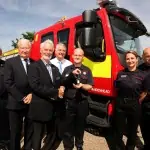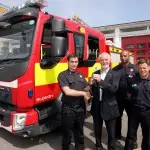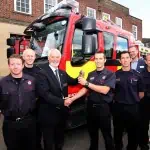Royal Berkshire Fire Authority has handed over the keys to four new fire engines to the county’s firefighters this week.
The four new fire engines are stationed at Caversham Road in Reading, Slough, Langley and Maidenhead and crews were handed the keys this week by Councillor Angus Ross from the Fire Authority.
The fire engines have been placed at the stations that currently receive the most over the border calls as part of a wider strategy to improve the ways in which Thames Valley fire and rescue services work together.
The official handover of the new fire engines took place at Langley and Slough on Monday 17 July, Maidenhead on Tuesday 18 July, and at Caversham Road Fire Station on Thursday 20 July.
Councillor Angus Ross, Strategic Asset Lead Member for Royal Berkshire Fire Authority, said: “I am delighted to hand the keys over to the crews on behalf of the Authority. It’s great to see a collaborative procurement process bring three fire and rescue services together to improve the way in which we work.
“These new fire engines were procured with crew efficiency, comfort and partnership working in mind, so I am pleased to hear that the firefighters have already reaped the benefits of the new appliances and the strategic plan for them to improve interoperability is already being put into practice.”
Chairman of Royal Berkshire Fire Authority, Councillor Colin Dudley, said: “On behalf of Royal Berkshire Fire Authority, I wanted to express my thanks to everyone involved in getting these new fire engines out to their respective stations and serving their local communities. Equipping our firefighters with these modern fire engines is just one of the ways we are increasing our resilience as a Service, alongside our Thames Valley colleagues.”
This follows the move to a joint Thames Valley control room in 2015 and this control centre mobilises the three Thames Valley fire and rescue services.
The new fire engines will enable better partnership working among the control staff and the front-line firefighters – increasing the benefit of having them at stations that regularly attend incidents in Oxfordshire and Buckinghamshire.
The fire engines were procured in partnership with Buckinghamshire & Milton Keynes and Oxfordshire Fire and Rescue Service. During the procurement, firefighters gave feedback alongside specialist research and equipment officers, and the fire engine supplier, to create a fire engine that is standardised between the three services whilst still working with the existing fleet of fire engines.
The standardised storage areas will make the equipment more easily and quickly accessible on arrival at an incident. This will increase how well the three fire and rescue services work together as firefighters from each will know where every piece of equipment is stored on another’s fire engine.
RBFRS’ focus is on prevention first these days and that means crews now spend more time than ever before on a fire engine completing home fire safety checks, attending community events and travelling to training exercises. As a result, firefighters could spend hours sat in the cab rather than the short time it takes to respond to an incident. With this in mind, the seating area in this newly designed engine has been built with crew comfort as a priority.
The fire engines have also been equipped with larger hose reels that deliver more water onto a fire so that they can be extinguished more quickly. Additionally, battery powered equipment has been added to reduce the total weight and size of items carried, enabling faster deployment when arriving at the scene of an incident.
In addition, there is now mobile lighting which can improve visibility at the scene of an incident at night or in poor weather conditions. The new lighting means that the incidents can benefit from the artificial light, which could increase some processes that can be slowed down if firefighters have to operate in the dark.
While there have been great improvements with the new fire engines, the layout and design was kept broadly similar to the existing appliances to ensure familiarity, although the crews still underwent a period of familiarisation before they began using the new vehicles to respond to incidents.



